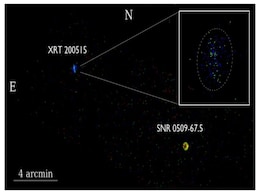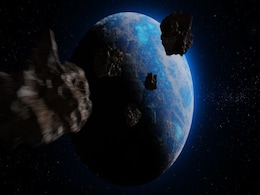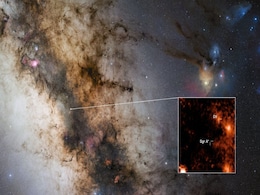Large Telescope
- All
- News
- Videos
-

This New Telescope Can Negate 'False-Positives' Of Alien Life Within Hours
- Friday April 4, 2025
- Science | Edited by Abhinav Singh
The ELT could identify biosignatures on planets in our solar system as well as orbiting Proxima Centauri within hours.
-
 www.ndtv.com
www.ndtv.com
-

James Webb Space Telescope Captures Hourglass Nebula LBN 483 in Stunning Detail
- Tuesday March 18, 2025
- Written by Gadgets 360 Staff
The James Webb Space Telescope has captured unprecedented details of LBN 483, a nebula located 650 light-years away. The striking hourglass-shaped structure results from outflows driven by a forming binary star system. JWST’s infrared imaging and ALMA’s radio observations reveal how stellar winds, jets, and magnetic fields sculpt the nebula ove...
-
 www.gadgets360.com
www.gadgets360.com
-

Unexpected Rotational Motion Detected in Ultra-Diffuse Galaxies of Hydra Cluster
- Wednesday March 5, 2025
- Written by Gadgets 360 Staff
Astronomers studying ultra-diffuse galaxies (UDGs) in the Hydra cluster have observed unexpected rotational movement in nearly half of the 30 galaxies examined. Spectroscopic data from the LEWIS programme, using the MUSE instrument on the Very Large Telescope, suggests that gravitational interactions with larger galaxies may influence their formati...
-
 www.gadgets360.com
www.gadgets360.com
-

Astronomers Spot Galaxy NGC 3640 With a Past of Consuming Smaller Galaxies
- Tuesday February 25, 2025
- Written by Gadgets 360 Staff
Recent observations of NGC 3640 reveal a history of merging with smaller galaxies. Located 88 million light-years away, the elliptical galaxy is suspected to be on a collision course with NGC 3641. The Very Large Telescope captured structural distortions, hinting at previous mergers. Researchers have identified ancient stars acting as fossil marker...
-
 www.gadgets360.com
www.gadgets360.com
-

Unusual X-ray Flash in Large Magellanic Cloud Puzzles Astronomers
- Tuesday February 25, 2025
- Written by Gadgets 360 Staff
A brief yet intense X-ray flash, XRT 200515, was detected in NASA's Chandra telescope data from 2000. The signal, originating from the Large Magellanic Cloud, has left scientists debating its cause. Possible explanations include a neutron star pulling in gas from a companion star or a powerful flare from a distant magnetar. Researchers also specula...
-
 www.gadgets360.com
www.gadgets360.com
-

Exoplanet WASP-121 b’s Atmosphere Features Iron Rains, Jet Streams, and More
- Thursday February 20, 2025
- Written by Gadgets 360 Staff
Astronomers have uncovered extreme weather patterns on WASP-121 b, a gas giant 900 light-years from Earth. The planet experiences iron rain, with metals vaporizing on its scorching dayside and condensing into liquid at night. Supersonic winds carry elements across its atmosphere, forming powerful jet streams. Using the Very Large Telescope, researc...
-
 www.gadgets360.com
www.gadgets360.com
-

Hubble’s New Image of Tarantula Nebula Showcases Cosmic Dust and Star Formation
- Tuesday February 18, 2025
- Written by Gadgets 360 Staff
NASA/ESA’s Hubble Space Telescope has captured a breathtaking image of the Tarantula Nebula, located 160,000 light-years away in the Large Magellanic Cloud. The image reveals intricate cosmic dust patterns and active star formation, offering valuable insights into the role of interstellar material in stellar evolution. Researchers are using the d...
-
 www.gadgets360.com
www.gadgets360.com
-

James Webb Telescope to Study Potentially Hazardous Asteroid 2024 YR4
- Thursday February 13, 2025
- Written by Gadgets 360 Staff
Asteroid 2024 YR4, identified in December 2024, has a 2.3% chance of Earth impact in December 2032. Due to uncertainties in ground-based size estimates, JWST will conduct infrared observations in March and May to determine its true dimensions. The European Space Agency estimates its width at 55 metres, but it could be as large as 90 metres. The fin...
-
 www.gadgets360.com
www.gadgets360.com
-

World’s Largest Telescope Dome Complete in Chile’s Atacama Desert
- Tuesday January 21, 2025
- Written by Gadgets 360 Staff
The construction of the Extremely Large Telescope (ELT) in Chile's Atacama Desert has reached a significant milestone with the completion of its dome's frame. The ELT, which will be the world’s largest visible- and infrared-light telescope, is being developed by the European Southern Observatory (ESO). The dome, measuring 305 feet in diameter and...
-
 www.gadgets360.com
www.gadgets360.com
-

Underwater Neutrino Telescopes Installed in Mediterranean to Study Cosmic Mysteries
- Wednesday December 25, 2024
- Written by Gadgets 360 Staff
Neutrino telescopes have been deployed in the Mediterranean Sea as part of the KM3NeT project to study high-energy cosmic particles. The project aims to detect neutrinos, elusive subatomic particles emitted from space, by using large underwater detectors. These detectors, consisting of glass spheres with photomultiplier tubes, are suspended in the ...
-
 www.gadgets360.com
www.gadgets360.com
-

Binary Star System D9 Found Orbiting Sagittarius A* Near Milky Way’s Core
- Thursday December 19, 2024
- Written by Gadgets 360 Staff
Astronomers have detected a young binary star system, D9, orbiting Sagittarius A*, the supermassive black hole at the Milky Way's centre. This challenges previous assumptions about star survival near intense gravitational forces. The discovery was made using the European Southern Observatory's Very Large Telescope. Future research with advanced tel...
-
 www.gadgets360.com
www.gadgets360.com
-

First Zoomed-in Picture of a Star Outside Our Galaxy Captured, Revealed to Be a Dying Star
- Monday November 25, 2024
- Written by Gadgets 360 Staff
The first detailed image of a star outside the Milky Way reveals WOH G64, a giant nearing its end. Captured by the Very Large Telescope Interferometer, this dying star, 1,500 times the size of the Sun, is surrounded by a cocoon of gas and dust, hinting at its eventual collapse into a supernova.
-
 www.gadgets360.com
www.gadgets360.com
-

Hubble Telescope Reveals Milky Way Blowing Gas off LMC Galaxy in Close Encounter
- Monday November 18, 2024
- Written by Gadgets 360 Staff
NASA’s Hubble Space Telescope has captured an extraordinary phenomenon as the Milky Way galaxy exerts ram pressure on the Large Magellanic Cloud (LMC), stripping away most of its gas halo. The interaction, which occurs as LMC passes near the Milky Way, has led to the loss of significant mass from the dwarf galaxy. Despite this, LMC retains enough...
-
 www.gadgets360.com
www.gadgets360.com
-

NASA’s Hubble Reveals Impact of Milky Way’s Gravitational Force on Large Magellanic Cloud
- Friday November 15, 2024
- Written by Gadgets 360 Staff
NASA’s Hubble Space Telescope recently observed the Large Magellanic Cloud (LMC) interacting with the Milky Way’s halo. Researchers found that the LMC’s gas halo has been significantly reduced, likely due to ram-pressure stripping. Despite this, the LMC retains enough gas to continue star formation. Future studies will focus on exploring othe...
-
 www.gadgets360.com
www.gadgets360.com
-

Discovery of Hidden Ninth Planet in Solar System Could Reshape Astronomy, Claims New Study
- Wednesday November 6, 2024
- Written by Gadgets 360 Staff
Scientists are exploring the possibility of a hidden ninth planet in our solar system. The planet, dubbed Planet Nine, is believed to exist beyond Neptune in the Kuiper Belt. Researchers have noticed unusual gravitational effects on distant objects in this region, which may be influenced by the presence of a large, unseen planet. While it has not b...
-
 www.gadgets360.com
www.gadgets360.com
-

This New Telescope Can Negate 'False-Positives' Of Alien Life Within Hours
- Friday April 4, 2025
- Science | Edited by Abhinav Singh
The ELT could identify biosignatures on planets in our solar system as well as orbiting Proxima Centauri within hours.
-
 www.ndtv.com
www.ndtv.com
-

James Webb Space Telescope Captures Hourglass Nebula LBN 483 in Stunning Detail
- Tuesday March 18, 2025
- Written by Gadgets 360 Staff
The James Webb Space Telescope has captured unprecedented details of LBN 483, a nebula located 650 light-years away. The striking hourglass-shaped structure results from outflows driven by a forming binary star system. JWST’s infrared imaging and ALMA’s radio observations reveal how stellar winds, jets, and magnetic fields sculpt the nebula ove...
-
 www.gadgets360.com
www.gadgets360.com
-

Unexpected Rotational Motion Detected in Ultra-Diffuse Galaxies of Hydra Cluster
- Wednesday March 5, 2025
- Written by Gadgets 360 Staff
Astronomers studying ultra-diffuse galaxies (UDGs) in the Hydra cluster have observed unexpected rotational movement in nearly half of the 30 galaxies examined. Spectroscopic data from the LEWIS programme, using the MUSE instrument on the Very Large Telescope, suggests that gravitational interactions with larger galaxies may influence their formati...
-
 www.gadgets360.com
www.gadgets360.com
-

Astronomers Spot Galaxy NGC 3640 With a Past of Consuming Smaller Galaxies
- Tuesday February 25, 2025
- Written by Gadgets 360 Staff
Recent observations of NGC 3640 reveal a history of merging with smaller galaxies. Located 88 million light-years away, the elliptical galaxy is suspected to be on a collision course with NGC 3641. The Very Large Telescope captured structural distortions, hinting at previous mergers. Researchers have identified ancient stars acting as fossil marker...
-
 www.gadgets360.com
www.gadgets360.com
-

Unusual X-ray Flash in Large Magellanic Cloud Puzzles Astronomers
- Tuesday February 25, 2025
- Written by Gadgets 360 Staff
A brief yet intense X-ray flash, XRT 200515, was detected in NASA's Chandra telescope data from 2000. The signal, originating from the Large Magellanic Cloud, has left scientists debating its cause. Possible explanations include a neutron star pulling in gas from a companion star or a powerful flare from a distant magnetar. Researchers also specula...
-
 www.gadgets360.com
www.gadgets360.com
-

Exoplanet WASP-121 b’s Atmosphere Features Iron Rains, Jet Streams, and More
- Thursday February 20, 2025
- Written by Gadgets 360 Staff
Astronomers have uncovered extreme weather patterns on WASP-121 b, a gas giant 900 light-years from Earth. The planet experiences iron rain, with metals vaporizing on its scorching dayside and condensing into liquid at night. Supersonic winds carry elements across its atmosphere, forming powerful jet streams. Using the Very Large Telescope, researc...
-
 www.gadgets360.com
www.gadgets360.com
-

Hubble’s New Image of Tarantula Nebula Showcases Cosmic Dust and Star Formation
- Tuesday February 18, 2025
- Written by Gadgets 360 Staff
NASA/ESA’s Hubble Space Telescope has captured a breathtaking image of the Tarantula Nebula, located 160,000 light-years away in the Large Magellanic Cloud. The image reveals intricate cosmic dust patterns and active star formation, offering valuable insights into the role of interstellar material in stellar evolution. Researchers are using the d...
-
 www.gadgets360.com
www.gadgets360.com
-

James Webb Telescope to Study Potentially Hazardous Asteroid 2024 YR4
- Thursday February 13, 2025
- Written by Gadgets 360 Staff
Asteroid 2024 YR4, identified in December 2024, has a 2.3% chance of Earth impact in December 2032. Due to uncertainties in ground-based size estimates, JWST will conduct infrared observations in March and May to determine its true dimensions. The European Space Agency estimates its width at 55 metres, but it could be as large as 90 metres. The fin...
-
 www.gadgets360.com
www.gadgets360.com
-

World’s Largest Telescope Dome Complete in Chile’s Atacama Desert
- Tuesday January 21, 2025
- Written by Gadgets 360 Staff
The construction of the Extremely Large Telescope (ELT) in Chile's Atacama Desert has reached a significant milestone with the completion of its dome's frame. The ELT, which will be the world’s largest visible- and infrared-light telescope, is being developed by the European Southern Observatory (ESO). The dome, measuring 305 feet in diameter and...
-
 www.gadgets360.com
www.gadgets360.com
-

Underwater Neutrino Telescopes Installed in Mediterranean to Study Cosmic Mysteries
- Wednesday December 25, 2024
- Written by Gadgets 360 Staff
Neutrino telescopes have been deployed in the Mediterranean Sea as part of the KM3NeT project to study high-energy cosmic particles. The project aims to detect neutrinos, elusive subatomic particles emitted from space, by using large underwater detectors. These detectors, consisting of glass spheres with photomultiplier tubes, are suspended in the ...
-
 www.gadgets360.com
www.gadgets360.com
-

Binary Star System D9 Found Orbiting Sagittarius A* Near Milky Way’s Core
- Thursday December 19, 2024
- Written by Gadgets 360 Staff
Astronomers have detected a young binary star system, D9, orbiting Sagittarius A*, the supermassive black hole at the Milky Way's centre. This challenges previous assumptions about star survival near intense gravitational forces. The discovery was made using the European Southern Observatory's Very Large Telescope. Future research with advanced tel...
-
 www.gadgets360.com
www.gadgets360.com
-

First Zoomed-in Picture of a Star Outside Our Galaxy Captured, Revealed to Be a Dying Star
- Monday November 25, 2024
- Written by Gadgets 360 Staff
The first detailed image of a star outside the Milky Way reveals WOH G64, a giant nearing its end. Captured by the Very Large Telescope Interferometer, this dying star, 1,500 times the size of the Sun, is surrounded by a cocoon of gas and dust, hinting at its eventual collapse into a supernova.
-
 www.gadgets360.com
www.gadgets360.com
-

Hubble Telescope Reveals Milky Way Blowing Gas off LMC Galaxy in Close Encounter
- Monday November 18, 2024
- Written by Gadgets 360 Staff
NASA’s Hubble Space Telescope has captured an extraordinary phenomenon as the Milky Way galaxy exerts ram pressure on the Large Magellanic Cloud (LMC), stripping away most of its gas halo. The interaction, which occurs as LMC passes near the Milky Way, has led to the loss of significant mass from the dwarf galaxy. Despite this, LMC retains enough...
-
 www.gadgets360.com
www.gadgets360.com
-

NASA’s Hubble Reveals Impact of Milky Way’s Gravitational Force on Large Magellanic Cloud
- Friday November 15, 2024
- Written by Gadgets 360 Staff
NASA’s Hubble Space Telescope recently observed the Large Magellanic Cloud (LMC) interacting with the Milky Way’s halo. Researchers found that the LMC’s gas halo has been significantly reduced, likely due to ram-pressure stripping. Despite this, the LMC retains enough gas to continue star formation. Future studies will focus on exploring othe...
-
 www.gadgets360.com
www.gadgets360.com
-

Discovery of Hidden Ninth Planet in Solar System Could Reshape Astronomy, Claims New Study
- Wednesday November 6, 2024
- Written by Gadgets 360 Staff
Scientists are exploring the possibility of a hidden ninth planet in our solar system. The planet, dubbed Planet Nine, is believed to exist beyond Neptune in the Kuiper Belt. Researchers have noticed unusual gravitational effects on distant objects in this region, which may be influenced by the presence of a large, unseen planet. While it has not b...
-
 www.gadgets360.com
www.gadgets360.com

















